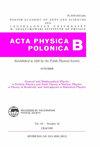原子形式因素的可选实现
IF 1.4
4区 物理与天体物理
Q3 PHYSICS, MULTIDISCIPLINARY
引用次数: 1
摘要
介子和反介子(真介子或双介子)的束缚态虽然很早以前就被预测到[1-4],但从未在实验中观察到。在文献中已经提出了许多产生dimuonium的机制。Dimuonium可以在固定目标实验[5-9]、电子-正电子碰撞[1,10 - 12]、基本粒子衰变[13-19]、夸克-胶子等离子体[20,21]、相对论重离子碰撞[21 - 23]、天体物理环境[24]或超慢介子束实验[25,26]中形成。作为昂贵而长期的超级粲- τ工厂项目第一阶段的一部分,Budker核物理研究所(Novosibirsk)目前正在制定计划,建造一台廉价、低能量的μμ-tron机器[27]。除了纯粹的加速器研究之外,μμ-tron将使实验产生和研究dimuonium成为可能。研究dimuonium与普通原子通过箔片时的相互作用是计划实验的一个组成部分。基本原子,如dimuonium,在通过箔时主要通过库仑势与普通原子相互作用[28-30]。这种相互作用是根据原子形式因素来处理的,可以在[31]中找到对原子形式因素计算的全面回顾。用群理论方法得到了[32]中类氢原子形状因子的一般解析公式。然而,这些公式的形式有些复杂,需要对传递动量[33]的每个值进行耗时的计算。在[33,34]中开发了一组更方便的公式,并在b[35]中作为FORTRAN程序实现。基于[36]中得到的数学结果,在本文中,我们提出了一种计算形状因子的替代方法,在某种意义上补充了[33,34]中提出的方法。作为本研究的副产品,在[37]中得到了一些涉及第二类切比雪夫多项式的三角恒等式。在本文中,我们使用dimuonium的原子单位,其中c = h = 1,质量单位为12mμ (dimuonium原子的约化质量),长度单位为dimuonium的第一玻尔轨道半径:aB = 2me μ a0≈512 fm,其中a0≈5.29× 10 m是通常的玻尔半径。虽然这篇文章的动机是新西伯利亚dimuonium计划,但我们强调所获得的结果实际上具有更广泛的兴趣,主要是在原子物理学方面,参见Devangan的评论文章[31]。本文章由计算机程序翻译,如有差异,请以英文原文为准。
Alternative Implementation of Atomic Form Factors
A bound state of muon and anti-muon (true muonium or dimuonium), although predicted long ago [1–4], has never been observed experimentally. Many mechanisms for the production of dimuonium have been proposed in the literature. Dimuonium can be formed in fixed-target experiments [5–9], in electron-positron collisions [1, 10–12], in elementary particle decays [13–19], in a quark-gluon plasma [20, 21], in relativistic heavy ion collisions [21–23], in an astrophysical context [24], or in experiments with ultra-slow muon beams [25, 26]. As part of the first stage of the expensive and long-term super charm-tau factory project, Budker Institute of Nuclear Physics (Novosibirsk) is currently developing plans to build an inexpensive, low-energy μμ-tron machine [27]. Apart from purely accelerator studies, the μμ-tron will make it possible to produce and investigate dimuonium experimentally. Studying the interactions of dimuonium with ordinary atoms as it passes through the foil is an integral part of the planned experiments. Elementary atoms, such as dimuonium, when passing through the foil interact with ordinary atoms predominantly via the Coulomb potential [28–30]. Such an interaction is treated in terms of atomic form factors, and a comprehensive review of atomic form factor calculations can be found in [31]. General analytical formulas for calculating the form factor of a hydrogen-like atom were obtained in [32] by grouptheoretical methods. However, these formulas have a somewhat complicated form, requiring time-consuming calculations for each value of a transfer momentum [33]. A more convenient set of formulas was developed in [33, 34] and implemented as a FORTRAN program in [35]. Based on the mathematical results obtained in [36], in this article we present an alternative method for calculating the form factor, which in some sense complements the method presented in [33, 34]. As a byproduct of this reaearch, some trigonometric identities involving Chebyshev polynomials of the second kind were obtained in [37]. Throughout the paper, we use dimuonium atomic units, in which c = h̄ = 1, the unit of mass is 12mμ (reduced mass in the dimuonium atom), and the unit of length is the radius of the first Bohr orbit in dimuonium: aB = 2 me mμ a0 ≈ 512 fm, where a0 ≈ 5.29× 10 m is the usual Bohr radius. Although the motivation for the article was Novosibirsk dimuonium program, we emphasize that the results obtained are in fact of much broader interest, mainly in atomic physics, see Devangan’s review article [31].
求助全文
通过发布文献求助,成功后即可免费获取论文全文。
去求助
来源期刊

Acta Physica Polonica B
物理-物理:综合
CiteScore
1.70
自引率
20.00%
发文量
30
审稿时长
3-8 weeks
期刊介绍:
Acta Physica Polonica B covers the following areas of physics:
-General and Mathematical Physics-
Particle Physics and Field Theory-
Nuclear Physics-
Theory of Relativity and Astrophysics-
Statistical Physics
 求助内容:
求助内容: 应助结果提醒方式:
应助结果提醒方式:


